西安市水资源可持续利用的探讨
- 格式:doc
- 大小:43.50 KB
- 文档页数:6
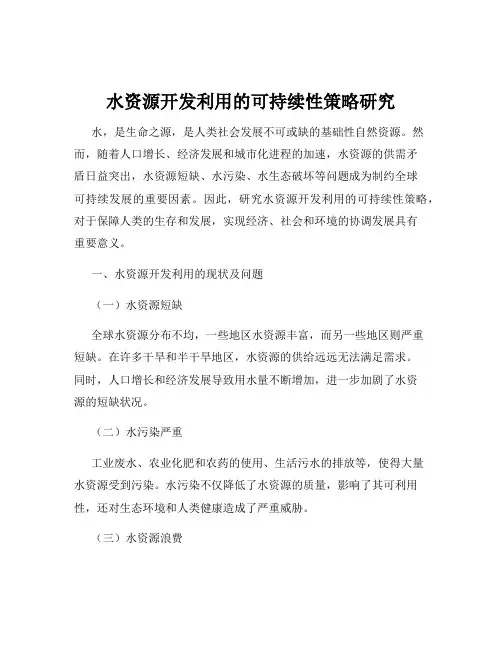
水资源开发利用的可持续性策略研究水,是生命之源,是人类社会发展不可或缺的基础性自然资源。
然而,随着人口增长、经济发展和城市化进程的加速,水资源的供需矛盾日益突出,水资源短缺、水污染、水生态破坏等问题成为制约全球可持续发展的重要因素。
因此,研究水资源开发利用的可持续性策略,对于保障人类的生存和发展,实现经济、社会和环境的协调发展具有重要意义。
一、水资源开发利用的现状及问题(一)水资源短缺全球水资源分布不均,一些地区水资源丰富,而另一些地区则严重短缺。
在许多干旱和半干旱地区,水资源的供给远远无法满足需求。
同时,人口增长和经济发展导致用水量不断增加,进一步加剧了水资源的短缺状况。
(二)水污染严重工业废水、农业化肥和农药的使用、生活污水的排放等,使得大量水资源受到污染。
水污染不仅降低了水资源的质量,影响了其可利用性,还对生态环境和人类健康造成了严重威胁。
(三)水资源浪费在农业灌溉、工业生产和居民生活中,水资源的浪费现象普遍存在。
例如,农业灌溉中大水漫灌的方式导致水资源利用率低下;工业生产中一些企业缺乏节水措施,用水效率不高;居民生活中,用水习惯不良,如长流水等现象时有发生。
(四)水生态破坏水资源的过度开发和不合理利用,导致了水生态系统的破坏。
河流断流、湖泊萎缩、湿地减少、地下水位下降等问题日益严重,影响了水资源的涵养和生态服务功能。
二、水资源开发利用可持续性的重要意义(一)保障人类生存和发展水是人类生存的基本需求,确保水资源的可持续供应对于满足人们的生活用水、保障粮食安全、促进经济发展至关重要。
(二)维护生态平衡健康的水生态系统对于维持生物多样性、调节气候、净化水质等具有重要作用。
实现水资源开发利用的可持续性,有助于保护和修复水生态系统,维护生态平衡。
(三)促进经济可持续发展水资源是许多产业的重要生产要素,合理开发利用水资源可以提高产业的生产效率和竞争力,推动经济的可持续发展。
三、水资源开发利用的可持续性策略(一)加强水资源管理建立健全水资源管理制度,明确水资源的权属和管理职责,加强水资源的统一规划和调配。
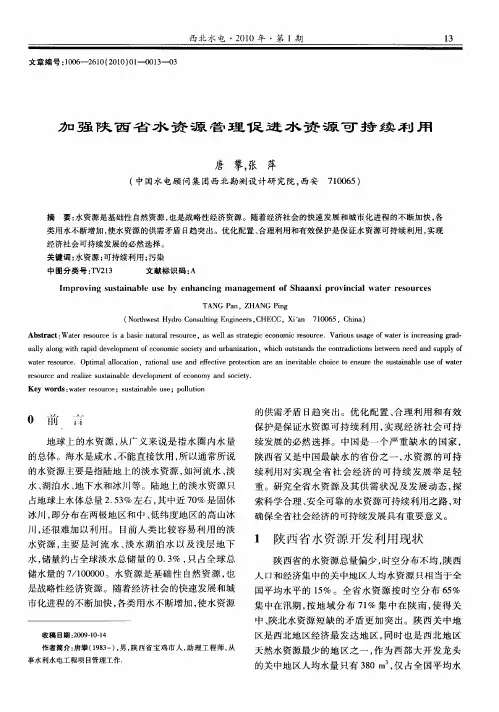

陕西西安水质问题严重水资源保护任务重尊敬的读者:近年来,陕西省西安市的水质问题日益严重,水资源保护任务变得十分紧迫。
作为一座重要的历史名城,西安不仅是中国古代文明的发源地之一,也是众多游客向往之地。
然而,随着城市规模的不断扩大和人口的快速增加,水质问题成为了城市可持续发展的障碍。
本文将就西安市水质问题进行探讨,并提出一些可行的解决方案。
一、西安水质问题的现状1. 水源污染严重西安市的水源主要来自于渭河、灞河和引黄灌区的供水径流,而这些水源已经遭受了严重的污染。
由于渭河和灞河流域的工业废水、农业面源污染和生活污水排放量大,水质已经明显下降。
在引黄灌区,不合理的农业灌溉方式导致了农药、化肥等农业面源污染物的大量入侵,直接威胁到了水质安全。
2. 地下水超采问题突出随着城市工业和生活用水的快速增长,西安市的地下水超采问题日益突出。
长期高强度可持续开采导致地下水位下降,水质下降以及土壤沉降等一系列环境问题的出现。
这不仅对城市供水安全构成了严峻挑战,也给生态环境和人民群众的健康带来了威胁。
二、西安水资源保护的挑战1. 宏观层面的问题在水资源保护方面,西安市存在着宏观层面的问题。
首先,政策法规体系不够完善,相关措施和制度缺乏针对性和执行力度。
其次,水资源管理和保护缺乏统一指挥部署,相关部门分散、信息共享不畅,导致监管不到位。
最后,公众缺乏水资源保护意识和环境保护意识,水资源浪费现象普遍存在。
2. 技术应用和管理问题在技术应用和管理方面,西安市也面临一系列挑战。
首先,水资源监测和预警体系不够健全,对于水质变化和危害的及时发现和预警存在困难。
其次,水资源开发和利用中缺乏先进的节水技术和管理经验,浪费严重。
最后,现有的环境监测能力和执法力度有限,监管难度大。
三、西安水资源保护的对策1. 政策法规的制定和完善针对西安市水资源保护的现状和挑战,我们应该加强政策法规的制定和完善。
建立健全水资源管理法律法规体系,强化对违法行为的处罚力度。
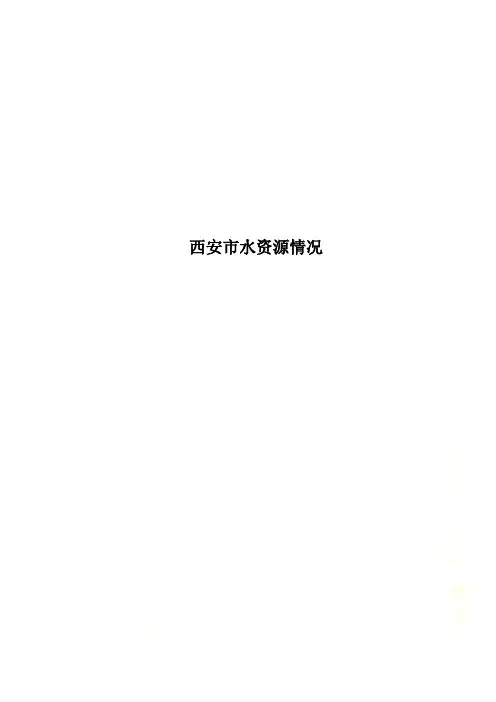
西安市水资源情况1 自然与社会经济状况西安市是陕西省省会,世界著名的历史文化名城,是我国中西部地区重要的教育\国防科技工业和高新技术产业基地。
西安地处八百里秦川腹地,地质地貌有秦岭山区、骊山丘陵区、黄土台塬区及关中的渭河平原区,是陕西省粮、棉、油、瓜果、蔬菜生产的重要基地。
1.1自然地理概况1.1.1地理位置西安市位于关中平原腹地,八百里秦川中部的渭河两岸。
地理坐标北纬33°39′~34°45′,东经107°40′~109°49′,东西长204Km,南北最大宽约116Km,面积10108Km2。
地形南高北低,呈阶梯结构,从南向北依次排列着秦岭山地、黄土丘陵沟壑,黄土台塬、山前冲洪积扇,渭河及其支流冲击平原。
平原地区高程400m左右,黄土台塬区500~700m之间,浅山丘陵区500~1000m,秦岭中高山区800~3000m,秦岭山地是西安市水资源涵养区。
1.1.2气候概况西安市属于暖温带半干旱、半湿润大陆性季风气候。
全是多年平均气温为13.3℃,日照时数1684~2243h,平原区干旱指数为1.29~2,无霜期220d左右,最大冻土厚度为45cm。
西安市多年平均降水量为740.4mm,其中秦岭山区835.6mm,台塬区708.5mm,丘陵区700.1mm,平原区637.5mm,降水受地形影响明显,总趋势由北向南逐渐增加,最低值在渭北,关山站多年平均降水量515.7mm,最高值为秦岭山区960.3mm,相差近一倍。
降水量年内分布不均,多集中在7、8、9、10四个月,占全年总降水量60%以上,最高达77.1%。
蒸发量在地区分布上与降水量相反,变化趋势由北向南逐渐减少,平原区向山区递减。
1.1.3河流水系西安市区域地貌,98.43%的面积在黄河流域,1.57%面积在长江流域;西安市主要河流水系分布纵横交错,素有“八水绕长安”的美称。
市区东有灞河、浐河,南有潏河、滈河,西有皂河、沣河、涝河、黑河,北有渭河、泾河、石川河等,其中集水面积大于50Km2的河流40余条,大于1000Km2的河流有六条。
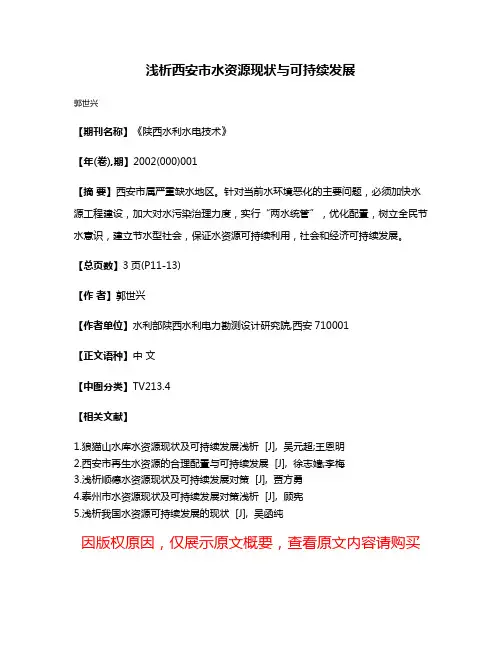
浅析西安市水资源现状与可持续发展
郭世兴
【期刊名称】《陕西水利水电技术》
【年(卷),期】2002(000)001
【摘要】西安市属严重缺水地区。
针对当前水环境恶化的主要问题,必须加快水源工程建设,加大对水污染治理力度,实行“两水统管”,优化配置,树立全民节水意识,建立节水型社会,保证水资源可持续利用,社会和经济可持续发展。
【总页数】3页(P11-13)
【作者】郭世兴
【作者单位】水利部陕西水利电力勘测设计研究院,西安710001
【正文语种】中文
【中图分类】TV213.4
【相关文献】
1.狼猫山水库水资源现状及可持续发展浅析 [J], 吴元超;王恩明
2.西安市再生水资源的合理配置与可持续发展 [J], 徐志嫱;李梅
3.浅析顺德水资源现状及可持续发展对策 [J], 贾方勇
4.泰州市水资源现状及可持续发展对策浅析 [J], 顾宪
5.浅析我国水资源可持续发展的现状 [J], 吴函纯
因版权原因,仅展示原文概要,查看原文内容请购买。
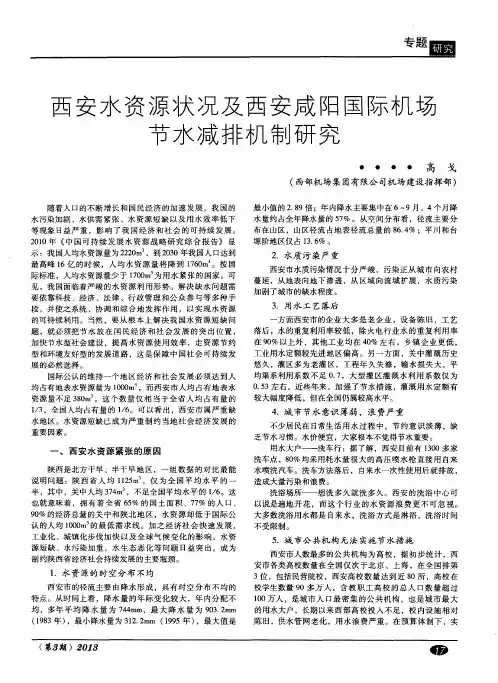

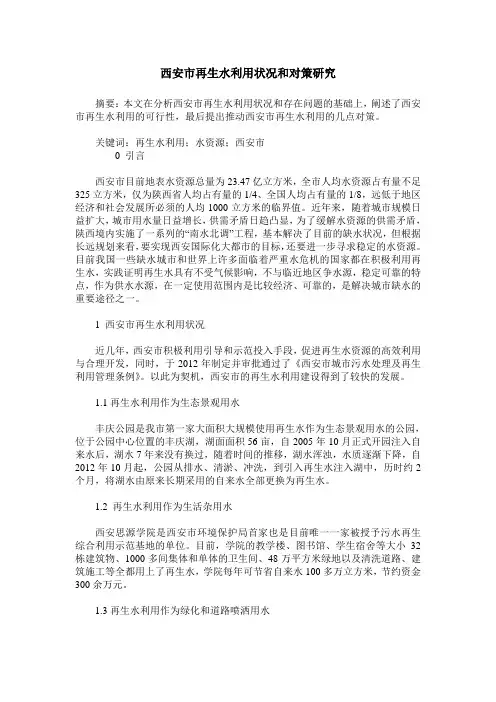
西安市再生水利用状况和对策研究摘要:本文在分析西安市再生水利用状况和存在问题的基础上,阐述了西安市再生水利用的可行性,最后提出推动西安市再生水利用的几点对策。
关键词:再生水利用;水资源;西安市0 引言西安市目前地表水资源总量为23.47亿立方米,全市人均水资源占有量不足325立方米,仅为陕西省人均占有量的1/4、全国人均占有量的1/8,远低于地区经济和社会发展所必须的人均1000立方米的临界值。
近年来,随着城市规模日益扩大,城市用水量日益增长,供需矛盾日趋凸显,为了缓解水资源的供需矛盾,陕西境内实施了一系列的“南水北调”工程,基本解决了目前的缺水状况,但根据长远规划来看,要实现西安国际化大都市的目标,还要进一步寻求稳定的水资源。
目前我国一些缺水城市和世界上许多面临着严重水危机的国家都在积极利用再生水,实践证明再生水具有不受气候影响,不与临近地区争水源,稳定可靠的特点,作为供水水源,在一定使用范围内是比较经济、可靠的,是解决城市缺水的重要途径之一。
1 西安市再生水利用状况近几年,西安市积极利用引导和示范投入手段,促进再生水资源的高效利用与合理开发,同时,于2012年制定并审批通过了《西安市城市污水处理及再生利用管理条例》。
以此为契机,西安市的再生水利用建设得到了较快的发展。
1.1再生水利用作为生态景观用水丰庆公园是我市第一家大面积大规模使用再生水作为生态景观用水的公园,位于公园中心位置的丰庆湖,湖面面积56亩,自2005年10月正式开园注入自来水后,湖水7年来没有换过,随着时间的推移,湖水浑浊,水质逐渐下降,自2012年10月起,公园从排水、清淤、冲洗,到引入再生水注入湖中,历时约2个月,将湖水由原来长期采用的自来水全部更换为再生水。
1.2 再生水利用作为生活杂用水西安思源学院是西安市环境保护局首家也是目前唯一一家被授予污水再生综合利用示范基地的单位。
目前,学院的教学楼、图书馆、学生宿舍等大小32栋建筑物、1000多间集体和单体的卫生间、48万平方米绿地以及清洗道路、建筑施工等全都用上了再生水,学院每年可节省自来水100多万立方米,节约资金300余万元。

促进水资源可持续利用共建人水和谐社会西安市黑河供水工程管理局邵革虎摘要:水资源不仅是资源环境安全问题,而且是关系到国家经济、社会可持续发展和长治久安的重大战略问题。
西安市是水资源严重短缺的城市。
目前,面临着水资源严重短缺、人为对水体的破坏严重等方面的问题。
也影响了城市经济的可持续发展及和谐社会建设。
因此,科学合理的调配和利用水资源,保障水资源持续稳步、安全,具有十分重要的现实意义和深远的历史意义。
本文主要分析了水资源与和谐社会的密切关系、水资源所面临的主要问题及其成因,在此基础上,提出了水资源的持续利用,保障水安全,促进和谐社会建设的主要对策和措施。
关键词:水资源持续利用水安全和谐社会按照《西安市国民经济和社会发展第十一个五年规划纲要》指导原则和发展目标,结合构建和谐社会的要求,扩大城乡就业,健全社会保障,调节收入分配,保障公共安全,促进社会事业全面发展……的具体要求,在十一五期间乃至今后相当长的一段时间内,水———将是制约西安发展的一个重要因素。
一、西安城市供水的现状西安市位于黄河流域中部关中盆地,北以陕甘黄土高原为边,秦岭山脉横旦于南,山脊海拔2000-2800m,是我国北与南的分水岭。
渭河及其众多支流冲积形成了关中平原。
西安正处在关中平原的腹地,关中人的“母亲河”、黄河的最大支流——渭河横贯其中(陕西境内境长370 Km,其中西安境内长约150Km,年平均径流量53亿m3)。
境内大部分河流属于黄河流域渭河水系(除秦岭南部汉江流域的胥水河,洵河以及直接流入黄河的南洛河外)。
西安市多年平均地表水资源量为21.78亿m3,多年平均地下水资源量为17.27亿m3,(扣除地表水和地下水之间的重复量12.39亿m3),全市水资源总量为26.66亿m3,按全市现有人口(2006年统计常住人口822.52万人)计算,人均占有地表水资源324m3,不足全省的1/3,全国人均占有量的1/6和世界人均占有量的1/24,远远低于国际公认的维持一个地区可持续发展人均占有量1000m3的临界值。

西安市水资源可持续利用的探讨(Discussion on Sustainable Utilization of water resources in Xi'an)Discussion on Sustainable Utilization of water resources in Xi'anFanchunxianShaanxi water conservancy and Electric Power Survey and Design Institute, Shaanxi, Xi'an 710001)Abstract: Xi'an is the central city in the west of China, the water shortage is serious, the contradiction between supply and demand is very prominent, water shortage has become an important factor restricting the sustainable development of economy and society. Based on the analysis of the current situation of water resources and water resources development and utilization in Xi'an City, this paper puts forward the reasonable and feasible development measures and Countermeasures to ensure the sustainable utilization of water resources.Key words: water resources; sustainable utilization; resource shortage; water resources protection; measuresWater is the source of life, water resources are irreplaceable natural resources, and it occupies an extremely important position in the sustainable development of social economy. The essence of sustainable utilization of water resources is to seek the coordination of water resources utilization, environmental protection and economic growth and socialdevelopment.Xi'an is the world-famous ancient capital of culture. It is the largest education, science and technology, industry and Commerce and tourism city in the the Yellow River River Basin. The urban area is 9983km22000. The total population of the city is 6 million 880 thousand. The water resources in Xi'an are extremely short, and the per capita water resources share is 316m3, which is only equivalent to 13% of the whole country. For a long time, the city relies on the single underground water supply, the groundwater is seriously over exploited, the groundwater level drops greatly, resulting in a series of environmental geological problems, such as land subsidence, building cracks and so on. The bell tower of the Ming Dynasty which symbolized the ancient civilization of Xi'an has sunk 395mm, and the wild goose pagoda in the Tang Dynasty tilts to the northwest in 1100mm. The situation is very grim. At the beginning of 1990s, the State Council approved the construction of Heihe water diversion project in Xi'an City, in 2002 after the completion of the project, the annual water supply of Xi'an city to 305 million m3, greatly easing the Xi'an city "water shortage" situation, but still can not meet the needs of the development of the city. According to the forecast, the total water demand of Xi'an in 2010 and 2030 was 3 billion 800 million m3 and 5 billion 100 million m3 respectively, while the water resources in the city was only 2 billion 666 million m3, and the water supply capacity was significantly less than the demand for water by economic and social development. Therefore, the optimal allocation of water resources, rational development and utilization of resources of water shortage in Xi'an is particularly important.General situation of water resources in Xi'an 11.1 total water resources1.1.1 river profileXi'an City, the river is mostly belongs to the the Yellow River River Basin of Weihe River, the city has a total of 54 large rivers, including the transit of 3 rivers, namely Weihe, Jinghe, ishikawa. Weihe is the largest tributary of the the Yellow River City, the length of 141km; Jinghe and Ishikawa river flows through the city's length were 8.5km and 30km. The rivers in Xi'an originate from the north foot of Qinling Mountains and the hills of Mount Li.1.1.2 water resourcesThe total amount of precipitation in Xi'an is 7 billion 420 million m3, and the amount of self-produced water is 2 billion 666 million m3, accounting for 36% of the precipitation. In the amount of self-produced water resources, the amount of surface water resources is 2 billion 178 million m3, the amount of groundwater resources is 1 billion 727 million m3, and the surface water and groundwater repetition is 1 billion 239 million m3. Xi'an city water off from Weihe, Jinghe, Ishikawa, whose values were 5 billion 570 million m3, 2 billion 66 million m3, 215 million m3, 7 billion 850 million m3 off the amount of water, add water off, the total amount of water resources in Xi'an city is 10 billion 520 million m3.Characteristics of 1.2 water resourcesThe temporal and spatial distribution of 1.2.1 water resources is unevenThe runoff in Xi'an is mainly formed by precipitation, which has the characteristics of uneven spatial and temporal distribution. From the time point of view, the interannual variation of precipitation is large, uneven distribution of the year, according to the statistical data of precipitation station Xiao village for 40 years, the average annual precipitation is 744mm, the maximum rainfall of 903.2mm (1983), the minimum precipitation is 312.2mm (1995), the maximum value is 2.89 times the minimum value of the year; the rainfall is concentrated in 6~9 months, four months precipitation accounted for about 57% of the annual precipitation. From the spatial distribution, the runoff is mainly distributed in the mountainous area, mountainous area accounts for 86.4% of the total runoff runoff; plain and tableland areas accounted for only 13.6%.1.2.2 is seriously polluted by waterWell, the river Meiyukou pH was 7.6~8.2, above the water, the total hardness is 51~146mg/l, salt 148~279 mg/l, basically reached the quality standard of class ii,Good water quality. The following into the Wei River mouth to Meiyukou dense population, serious water pollution, as the basic grade v.Weihe, Jinghe, Ishikawa river pollution is more prominent, the water quality of Weihe section of Xi'an has exceeded the class V, Jinghe, Ishikawa Ann West Water segment IV and V respectively. The pollution of water quality in Weihe directly affects the groundwater in coastal Xi'an city. At present, the area of groundwater pollution in urban and suburban areas of Xi'an is more than 470km2, of which the heavy pollution area has reached 130 km2, the main pollutants are fluoride, arsenic, six valent cadmium and other toxic substances.The water pollution in Xi'an is very serious. The pollution is spreading from the city to the countryside, from the surface to the underground, and from the region to the river basin. The water pollution aggravates the water shortage in the city.Present situation and existing problems of water resources development and utilization in 2Development and utilization of water resources in 2.1Present situation of 2.1.1 water supply project facilities(1) groundwater supply projectIn 2000, there were 211 water supply wells in Xi'an, and the water supply capacity was 420 thousand m3/d.(2) surface water supply projectIn 1986, Chan River built surface water regulation project, water supply capacity of 3~12 million m3/d. Before and after1996 in Xi'an city water supply is extremely difficult circumstances, the provincial government decided to Shibianyu, Feng Yu, Tian Yu, black Valley and stone river into Xi'an, the ability of water supply facilities for 60m3/d. Heihe water diversion project in Xi'an city in 2002 after the completion of the Heihe water supply capacity of the system is 1 million 100 thousand m3/d (including Shibianyu, Feng Yu, Tian Yu, black Valley and stone river water supply capacity of 60m3/d).2.1.2 water supply capacityIn 2000, the water supply capacity of Xi'an city was 105~114 million m3/d, of which the groundwater supply was 420 thousand m3/d, the surface water supply was 62~72 million m3/d, and the water supply population was 2 million 277 thousand people.Built in 2002 in Heihe Jinpen Reservoir, surface water supply capacity of 113~122 million m3/d, considering the water supply capacity of underground water decreases by 3%, the water supply capacity of groundwater is 400 thousand m3/d, the actual water supply capacity of the city center area of 153~162 million m3/d.Current water consumption of 2.1.3In 2000, the urban water consumption of Xi'an was 1 million 650 thousand m3/d, and the total water consumption was 601 million m3, including 264 million m3 of domestic water, 337 million m3 of industrial water, and 50~60 m3/d of water shortage.In 2002, the urban central water consumption was 1 million 930 thousand m3/d, the total water consumption was 703 million m3,and water shortage was still 30~40 m3/d.Problems in the development and utilization of 2.2 water resources2.2.1 is seriously deficient in water resources and backward in water utilization processXi'an is the core of economic development in Guanzhong region, and also the key to Shaanxi's economic take-off. Population is dense and water shortage is serious. According to the city's land, population, per capita water volume is 491m3/ mu, the per capita water resources for 316m3/, respectively, the global water resources per mu of 26% and 21%, the per capita water resources in 13% and 4%, the amount of water per capita is far below the international absolute lack of water 500 M3 that is a shortage of water resources in the city. From the situation of Shaanxi Province, the Guanzhong area accounts for 57.9% of the province's population, and the water resources is only 18.4% of the province. Water shortage has become the bottleneck restricting the sustainable development of the cities along the coast of Weihe". In addition, most of the enterprises in Xi'an city is an old enterprise, obsolete equipment, backward technology, water reuse rate is low, the thermal power industry, water reuse rate of 90% or more, other industries were around 40%, lower township enterprises, industrial water quota high advanced area. On the other hand, Guanzhong irrigation has a long history, most of the irrigation areas are old irrigation areas, the project is in disrepair, the water loss is large, the average canal utilization coefficient is less than 0.7, and the irrigation water use coefficient is only about 0.53 in largeirrigation districts. In recent years, water saving measures have been strengthened, and irrigation water quota has been greatly reduced, but it is still in a high level throughout the country.2.2.2 surface water pollution is serious, affecting groundwater, Weihe water environment protection crisisWeihe is the mother river of Shaanxi people, runs through the Guanzhong Plain, along the coast of Baoji, Xianyang, Xi'an, Tongchuan, Weinan and other large and medium-sized cities, population concentration, industrial development.The lack of water resources, water pollution and sediment deposition in the Sanmenxia reservoir area have seriously restricted the sustainable development of economy in Xi'an and Guanzhong areas.In the past ten years, the amount of water in Weihe has decreased year by year. The water quantity in the section of Lin village in Weihe in 1997 is only 402 million m3, which is the worst value in 50 years. Huaxian section has appeared for three consecutive days off phenomenon. The sharp decline in water consumption has made urban life and industrial and agricultural water use extremely tight, and ecological water use has become more scarce. At present, the economic development of Guanzhong City is maintained by over exploitation of groundwater and sacrifice of ecological water. At the same time, Weihe as the only sewage channel in Guanzhong area, along the city to accept a large number of domestic sewage and industrial wastewater, with the development of economy, the amount of sewage sewage emissionsincreased year by year, in 2000 reached 9.29 tons, is 3 times that of 80s. The decrease of water quantity and the increase of sewage discharge in Weihe have led to a sharp deterioration of water quality. The lower reaches of Baoji gorge are all water quality of class V and beyond, which basically lost the function of water use.The main sources of water supply along the coast of Weihe are groundwater exploitation along the river, and the pollution of surface water has spread to groundwater, which seriously affects the people's life and health.2.2.3 groundwater overdraft, environmental geological problems highlightedAfter entering 80s, groundwater exploitation in Xi'an increased rapidly, the largest mining capacity of 700 thousand m3/d, 140 thousand M3, over exploitation of groundwater, the groundwater level continued to decline the city area, a large range of funnel, subsidence and other environmental geological problems. Southeast groundwater depth decreased from 30m to 50~80m, the depth of 137m, the formation of Feng, Ba, Chan, Wei, soap five large funnel, appeared in the Northeast suburbs of Southern Xiao Zhai Hu Jiamiao, big wild goose pagoda, Southeast, southwest suburb of Shapo, four settlement center Northwestern University. The ground subsidence area of the city reached 162km22000, and more than 100 buildings were destroyed in varying degrees.3. Measures and Countermeasures for sustainable utilization of water resources3.1, do a good job of water-saving planning, take practical measures to achieve water-saving goalsIn view of the current situation of water scarcity in Xi'an and the actual situation of urban development, the urban water saving is mainly considered from the following aspectsIndustrial water saving:Industrial water consumption accounts for a large proportion of urban water consumption, and it is the key point of urban water saving. Water saving is mainly achieved by combining technical measures and administrative measures, and the specific measures are as follows:(1) adopting administrative measures to promote industrial water savingBy adjusting the industrial structure, the industrial layout will develop in a reasonable direction. Strict water licensing examination and approval system, the new construction, reconstruction and expansion of the project must be carried out water resources demonstration, while supporting the corresponding water-saving measures.(2) increase the reuse rate of waterIncreasing the reuse rate of water is an important measure to reduce water consumption and discharge capacity. The cooling water and air conditioning water should be recycled as much aspossible, and the process water and other water should be reused as much as possible.(3) popularize water saving equipment, improve production process, reduce water consumption in productionWater saving in urban life: measures to reduce water loss in pipe network, popularize water-saving appliances, strengthen planned water use, advocate water use, eliminate waste and so on.Agricultural irrigation water saving: through irrigation area water-saving transformation, improve water resources utilization rate, adjust the planting structure of crops, strengthen irrigation water management, promote newwater-saving irrigation technology and other measures to achieve water-saving irrigation.Through the above measures, by 2010, the water saving in Xi'an can increase by 85 million m3.3.2, promote the pace of sewage recycling, speed up the construction of sewage treatment plantsWastewater treatment and reuse can not only reduce pollution, but also increase water supply and alleviate the contradiction of water shortage. Xi'an city sewage emissions of more than 1 million m3, plan in 2010 to build four sewage treatment plants, the daily processing capacity of a total of 600 thousand m3/d, sewage treatment can increase 210 million m3 of water, sewage after treatment respectively for city greening, parks, riversand municipal use and living water etc..3.3 through engineering measures to achieve sustainable use of water resourcesFrom the regional distribution of water resources in Shaanxi, the amount of surface water resources in Guanzhong area is 7 billion 370 million m3, and that of Southern Shaanxi is 312.500 million m3, the surface water resources in southern Shaanxi is 4.24 times of Guanzhong area. From the population and arable land distribution, Guanzhong area population and arable land accounted for 57.9% and 49.4% of the province, Shaanxi province accounted for only 24.6% and 19.4% of the province. Visible, uneven distribution of water resources and population, arable land. On the one hand, the water resources in Guanzhong area are seriously short of water, the social and economic development relies on the exploitation of groundwater and the ecological water; on the other hand, the water resources in southern Shaanxi can not be rationally utilized. In order to realize the sustainable utilization of water resources and promote the optimal allocation of water resources, the experts have repeatedly demonstrated and compared the water resources planning scheme of Shaanxi, and put forward the south to North Water Diversion Project, which has three lines. The project of the YINHONGJISHI water diversion project, is a tributary of the Hanjiang River Baohe River upstream through the Qinling Mountains Hongyan river tunnel into the stone river, diversion of water 94 million m3, the total investment of 598 million yuan. Dry stone Ji - cited the East Route Project of water diversion project, will you dry river through Qinling Mountains JianghanBranch tunnel in Xi'an Shibianyu reservoir, in water 49 million 430 thousand M3, the total investment of 200 million yuan. The project of diverting water from Hanjiang to Weihe River is the largest project in the three South to North Water Diversion project. The project is the construction of Three Gorge reservoir, gold river reservoir built on the river in the meridional tributary Hanjiang River, through the gorge, three gold river reservoir dispatching, the Hanjiang River water from the three through the Qinling Mountains river reservoir water diversion in Heihe, diversion of water 1 billion 500 million m3, the total investment of 7 billion 800 million yuan. The project was implemented by stages, and three estuary reservoir was built before 2010. The water transfer capacity was 500 million m32010, and the remaining works were completed after 2000 years.After the implementation of the above water transfer project, the water quantity can be adjusted to 948 million m3 in 2010; after the completion of the project, the water transfer capacity reaches 1 billion 648 million m3. The implementation of water diversion project, to solve the shortage of water resources, improve the water environment in Weihe, promote the Guanzhong Economic Development will play an extremely important role, is the optimal allocation of water resources, rational development and utilization and important measures to realize the sustainable utilization of water resources inXi'an.3.4, strengthen the protection of water resources in Weihe, improve the water environment, improve water functionAt present, the water pollution in Baoji gorge below Weihe is very serious. The key to protect water resources in Weihe lies in the prevention and control of pollution. Industrial pollution should be reduced by adjusting the industrial structure, implementing cleaner production technology, reducing the amount of waste water discharge, implementing the total amount control of pollutants, increasing the law enforcement efforts and other measures to reduce the waste water discharge. Urban sewage should be controlled by centralized treatment and decentralized treatment to speed up the construction of waste water treatment facilities and other measures to control the discharge of waste water. In addition, it is also an important measure to protect water resources, improve water environment and improve water function by optimizing water resources allocation, increasing river water supply, strengthening river channel dilution and self purification ability.***[JimiSoft: Unregistered Software ONLY Convert Part Of File! Read Help To Know How To Register.]***。
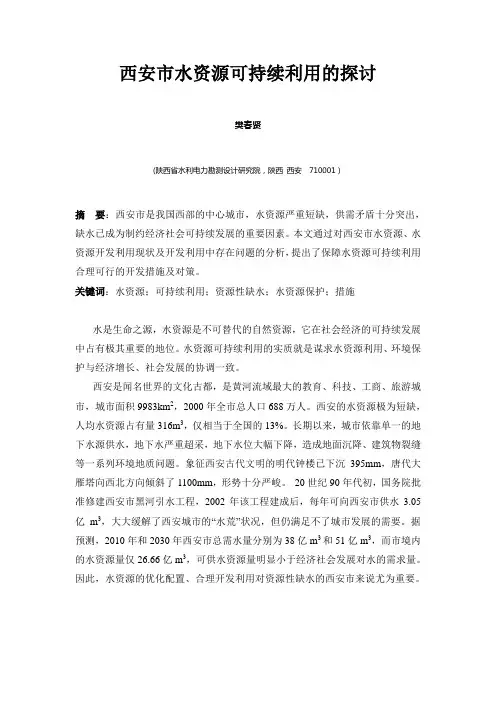
西安市水资源可持续利用的探讨樊春贤(陕西省水利电力勘测设计研究院,陕西西安710001)摘要:西安市是我国西部的中心城市,水资源严重短缺,供需矛盾十分突出,缺水已成为制约经济社会可持续发展的重要因素。
本文通过对西安市水资源、水资源开发利用现状及开发利用中存在问题的分析,提出了保障水资源可持续利用合理可行的开发措施及对策。
关键词:水资源;可持续利用;资源性缺水;水资源保护;措施水是生命之源,水资源是不可替代的自然资源,它在社会经济的可持续发展中占有极其重要的地位。
水资源可持续利用的实质就是谋求水资源利用、环境保护与经济增长、社会发展的协调一致。
西安是闻名世界的文化古都,是黄河流域最大的教育、科技、工商、旅游城市,城市面积9983km2,2000年全市总人口688万人。
西安的水资源极为短缺,人均水资源占有量316m3,仅相当于全国的13%。
长期以来,城市依靠单一的地下水源供水,地下水严重超采,地下水位大幅下降,造成地面沉降、建筑物裂缝等一系列环境地质问题。
象征西安古代文明的明代钟楼已下沉395mm,唐代大雁塔向西北方向倾斜了1100mm,形势十分严峻。
20世纪90年代初,国务院批准修建西安市黑河引水工程,2002年该工程建成后,每年可向西安市供水3.05亿m3,大大缓解了西安城市的“水荒”状况,但仍满足不了城市发展的需要。
据预测,2010年和2030年西安市总需水量分别为38亿m3和51亿m3,而市境内的水资源量仅26.66亿m3,可供水资源量明显小于经济社会发展对水的需求量。
因此,水资源的优化配置、合理开发利用对资源性缺水的西安市来说尤为重要。
1 西安市的水资源概况1.1 水资源总量1.1.1 河流概况西安市的河流大多属黄河流域渭河水系,市内共有54条较大的河流,其中过境河流3条,分别为渭河、泾河、石川河。
渭河是黄河最大的支流,市内长度141km;泾河和石川河流经市内的长度分别为8.5km和30km。
1 自然与社会经济状况西安市是陕西省省会,世界著名的历史文化名城,是我国中西部地区重要的教育\国防科技工业和高新技术产业基地。
西安地处八百里秦川腹地,地质地貌有秦岭山区、骊山丘陵区、黄土台塬区及关中的渭河平原区,是陕西省粮、棉、油、瓜果、蔬菜生产的重要基地。
1.1自然地理概况1.1.1地理位置西安市位于关中平原腹地,八百里秦川中部的渭河两岸。
地理坐标北纬33°39′~34°45′,东经107°40′~109°49′,东西长204Km,南北最大宽约116Km,面积10108Km2。
地形南高北低,呈阶梯结构,从南向北依次排列着秦岭山地、黄土丘陵沟壑,黄土台塬、山前冲洪积扇,渭河及其支流冲击平原。
平原地区高程400m左右,黄土台塬区500~700m之间,浅山丘陵区500~1000m,秦岭中高山区800~3000m,秦岭山地是西安市水资源涵养区。
1.1.2气候概况西安市属于暖温带半干旱、半湿润大陆性季风气候。
全是多年平均气温为13.3℃,日照时数1684~2243h,平原区干旱指数为1.29~2,无霜期220d左右,最大冻土厚度为45cm。
西安市多年平均降水量为740.4mm,其中秦岭山区835.6mm,台塬区708.5mm,丘陵区700.1mm,平原区637.5mm,降水受地形影响明显,总趋势由北向南逐渐增加,最低值在渭北,关山站多年平均降水量515.7mm,最高值为秦岭山区960.3mm,相差近一倍。
降水量年内分布不均,多集中在7、8、9、10四个月,占全年总降水量60%以上,最高达77.1%。
蒸发量在地区分布上与降水量相反,变化趋势由北向南逐渐减少,平原区向山区递减。
1.1.3河流水系西安市区域地貌,98.43%的面积在黄河流域,1.57%面积在长江流域;西安市主要河流水系分布纵横交错,素有“八水绕长安”的美称。
市区东有灞河、浐河,南有潏河、滈河,西有皂河、沣河、涝河、黑河,北有渭河、泾河、石川河等,其中集水面积大于50Km2的河流40余条,大于1000Km2的河流有六条。
西安市黑河地表水源地水环境质量评价及可持续利用对策郑国璋【摘要】Through investigating and sampling in the surface water surface field of Heihe river of Xi' an city, the pH, TP, COD, NH3-N, As,Cd, Pb, Cr6+ and CN were chosen and analyzed as the appraisal factors of the environmental quality of surface water surface field of Heihe river according to the Environmental Water Quality Standard of Surface Water ( GB3838-2002 ). The results indicated that all pollution indexes of main monitoring items were less than or equal to 1, the value of the composite pollution index P was 0.72, the environmental quality of surface water source field of Heihe River reached the Standard of GB3838-2002 I on the whole, which met the demands of centralized living water supply source for Xi' an and the construction of national reserve. According to the problems in protecting the environment of surface water source field of Heihe River, some measures were proposed for the sustainable utilization of Heihe surface water source field.%通过对西安市黑河地表水源地考察与采样,选取pH、总磷(TP)、化学需氧量(COD)、氨氮(NH3-N)与重金属元素砷(As),镉(Cd)、铅(Pb)、六价格(Cr6+)、氰化物(CN-)等9个项目作为黑河地表水源地水环境质量评价因子.依据国家<地表水环境质量标准>(GB3838-2002)I类水质标准进行监测分析.评价结果表明:黑河地表水源地水样主要监测项目污染指数Pi值均小于或等于1,综合污染指数P值为0.72,水环境质量总体上达到国家I类水质标准,符合西安市集中式生活供水源地及国家自然保护区建设的要求.针对黑河地表水源地水环境质量保护中存在的问题,提出了黑河地表水源地可持续利用的对策.【期刊名称】《安徽农业科学》【年(卷),期】2011(039)019【总页数】3页(P11671-11673)【关键词】水源地;水环境质量;可持续利用;黑河;西安市【作者】郑国璋【作者单位】重庆师范大学地理与旅游学院,重庆,400047【正文语种】中文【中图分类】X131.2黑河地表水源地金盆水库水利枢纽工程的建成供水,大大缓解了西安市由于地下水严重超采导致的地面下沉、地裂缝等环境地质问题,对西安市社会经济的稳定和发展具有十分重要的作用。
应对西安市水资源问题的思考与建议——浐灞生态区水环境治理范式(第十三期处级公务员培训学员第三课题组)内容提要:水是重要的自然资源,是人类社会发展必不可少的物质基础。
逐水而居,自古以来就是人类生存的基本方式。
中国历史上先后有13个王朝在西安建都,古都的变迁和当时水资源及环境问题密切相关。
当今,西安已成为我国中西部地区重要的工业、科技、商贸、旅游和文化中心。
随着城市规模的日益扩大,西安市将形成“东连临潼、西接咸阳、南拓长安、北跨渭河”的发展新格局,昔日的“八水绕长安”将不可避免的成为西安的城中河。
国务院在《关中—天水经济区发展规划》中将西安定位为国际化大都市。
所以,水的经济价值、生态价值、资源价值和人文价值尤为重要。
然而长期以来,水资源短缺一直是制约西安经济社会发展的主要因素。
进入本世纪后,西安市委、市政府把水问题放在首要位置来抓,尤其是水环境治理进程明显加快。
孙清云同志明确指出:“西安要实现可持续发展,必须下大力气解决水的问题”。
实践证明,解决好水问题,对建设国际化大都市的西安来说,是一个紧迫而重大的战略问题。
就水量而言,西安市水资源总量为26.87亿立方米,人均水资源占有量不到350立方米,相当于全省人均量的1/3,全国人均量的1/6、世界人均量的1/25,远远低于国际公认500立方米的绝对缺水线,是全国最缺水的城市之一。
另外,随着西安市经济社会的全面发展,供水、蓄水、调水、节水、排水、治水等问题尤显凸出。
目前,关于西安市水问题多倾注于“水量”的理论研究,抑或涉及“水质”和某单一问题的探讨,而关于水环境治理的思路尚未形成系统和完整的构架,致使城市因缺水总觉“血脉不旺”。
从战略上讲,水环境治理既是解决西安水资源矛盾的有效途径,又是彰显西安水生态品相的最佳选择。
本文用浐灞生态区水环境治理的五个范式,针对性的探讨了西安市水资源的五个问题,并提出五项建议。
正文:一、对西安市水资源问题的思考1.水资源总量偏少,制约经济发展。
西安水资源利用情况及对再生水的需求请按以下几部分梳理:1、西安水资源现状(引出水资源短缺)降雨量+蒸发量+用水量人均水资源占有量及使用量计算说明缺水量(水量+资源型水质缺水)2、西安水资源短缺带来的问题环境问题(地面沉降)经济问题(水资源费)“资源型缺水”“经济性缺水”,即虽然水资源总量并不缺乏,但缺乏相应技术、能力。
3、解决水资源短缺的途径(引出再生水)1、引水(不经济)2、开发利用地下水(水量有限、环境问题突出)3、非常规水资源利用(雨水+再生水)最好的途径雨水的量不能保障、再生水水量稳定、目前再生水处理工艺成熟体现出再生水是目前解决水资源短缺的最好途径4、再生水需求量和潜力分析水量和水质都可以保证建议:1)数据序列尽量从2000年开始;2)分析对比尽量能够丰满一些,能够充分说明你的观点,显得有理有据;3)总结的话语尽量言简意赅,西安是西北地区中心城市,地处内陆,近年来干旱少雨,天然水资源极为有限,属于“资源型缺水”城市。
西安人均水资源占有量远低于全国平均水平,仅为350 m3/a,远远低于1000m3这一国际公认的维持社会经济环境所需的临界值。
据统计,西安市1990年供水高峰季节缺口高达40万立方米/日。
夏季时供水区域内约有20%的区域断水,影响人口约13万余人。
用水高峰期时对工业用水进行减压限产,造成许多企业因供水不足而被迫减产或停产。
自“西部大开发”战略实施以来,西安城市规模不断扩大,用水基数不断增加,水质标准不断提高,用水已多次出现供需危机。
由图1-1可知西安的人均年用水量仅为全国人均年用水量的1/9。
可以预测,这种供需矛盾将在未来相当长的一段时间内更加突出。
图1-1从长远看,不解决城市供水这一基础性问题,“西部大开发”战略就不可能取得成功。
解决供水问题无非有两种解决办法,一是开源,二是节流。
西安作为内陆城市,无法像一些沿海城市通过处理海水来获得用水。
而为解决饮用水短缺的问题,西安曾严重开采地下承压水,导致地下水资源不断减少。
陕西省水资源可持续利用对策初探- 水利论文作者:佚名文章来源:不详点击数:4369 更新时间:2006-7-121陕西省水资源基本情况陕西省地处内陆腹地,属大陆性气候,多年平均降水量仅680mm。
全省拥有水资源总量442×108m3,人均水资源占有量为1340m3,分别占全国平均水平的54%。
有限的水资源在时空、地域上分布不均,且与人口、耕地和工业布局极不相称,进一步加剧了水资源的供需矛盾。
秦岭以南的长江流域,土地面积占全省的35%,而水资源量占全省的71%;秦岭以北的黄河流域,土地面积占全省面积的65%,而水资源量仅占全省的29%。
其中在关中地区,人均占有水源量285m3,每亩耕地平均占有水资源量为215m3,仅为全国水平的1燉6和1燉8,是全省最缺水的地区。
长期以来,缺水不仅影响农业发展和工业生产,同时制约着城市建设发展和人民生活水平的改善提高,成为我省实施对外开放,促进经济社会可持续发展的“瓶颈”。
2陕西省水资源可持续利用面临的挑战2.1水资源供需形势将日趋严峻经过多年建设,陕西省累计建成了20多万处水利工程,其中水库1097座,具有百万方以上水库158座,总库容41.2×108m3但仍难以满足国民经济的发展要求。
据统计,现状年缺水多达26×108m3,其中农业缺水18×108m3,城市和县城缺水5×108m3,工业生产缺水近3×108m3。
从全省水资源总体供给状况来看,关中及陕北地区水资源供给形势更为严峻。
根据全省国民经济发展规划,预计到2010年,全省需水将达到168×108m3,随着全省经济的发展,城市化进程的加快,人民生活水平的日益提高,全省对水的需求将越来越大,水资源供需矛盾将日益尖锐。
2.2水资源开发和保护难度较大从传统概念上,解决水资源供需矛盾应从开源和节流两方面着眼,根据陕西省国民经济发展对水的需求,仅仅依靠挖掘现有水利工程自身潜力,以及加大全省节水力度,仍难以解决问题,因此必须同时考虑对水资源开发的研究。
西安市水资源可持续利用的探讨樊春贤(陕西省水利电力勘测设计研究院,陕西西安 710001)摘要:西安市是我国西部的中心城市,水资源严重短缺,供需矛盾十分突出,缺水已成为制约经济社会可持续发展的重要因素。
本文通过对西安市水资源、水资源开发利用现状及开发利用中存在问题的分析,提出了保障水资源可持续利用合理可行的开发措施及对策。
关键词:水资源;可持续利用;资源性缺水;水资源保护;措施水是生命之源,水资源是不可替代的自然资源,它在社会经济的可持续发展中占有极其重要的地位。
水资源可持续利用的实质就是谋求水资源利用、环境保护与经济增长、社会发展的协调一致。
西安是闻名世界的文化古都,是黄河流域最大的教育、科技、工商、旅游城市,城市面积9983km2,2000年全市总人口688万人。
西安的水资源极为短缺,人均水资源占有量316m3,仅相当于全国的13%。
长期以来,城市依靠单一的地下水源供水,地下水严重超采,地下水位大幅下降,造成地面沉降、建筑物裂缝等一系列环境地质问题。
象征西安古代文明的明代钟楼已下沉395mm,唐代大雁塔向西北方向倾斜了1100mm,形势十分严峻。
20世纪90年代初,国务院批准修建西安市黑河引水工程,2002年该工程建成后,每年可向西安市供水3.05亿m3,大大缓解了西安城市的“水荒”状况,但仍满足不了城市发展的需要。
据预测,2010年和2030年西安市总需水量分别为38亿m3和51亿m3,而市境内的水资源量仅26.66亿m3,可供水资源量明显小于经济社会发展对水的需求量。
因此,水资源的优化配置、合理开发利用对资源性缺水的西安市来说尤为重要。
1 西安市的水资源概况1.1 水资源总量1.1.1 河流概况西安市的河流大多属黄河流域渭河水系,市内共有54条较大的河流,其中过境河流3条,分别为渭河、泾河、石川河。
渭河是黄河最大的支流,市内长度141km;泾河和石川河流经市内的长度分别为8.5km和30km。
西安市境内河流均发源于秦岭北麓和骊山丘陵。
1.1.2 水资源量西安市降水总量为74.2亿m3,自产水资源量为26.66亿m3,占降水量的36%。
自产水资源量中,地表水资源量为21.78亿m3,地下水资源量为17.27亿m3,地表水和地下水的重复量为12.39亿m3。
西安市的客水量来源于渭河、泾河、石川河,其值分别为55.7亿m3、20.66亿m3、2.15亿m3,客水总量为78.5亿m3,加入客水量后,西安市水资源总量为105.2亿m3。
1.2 水资源特性1.2.1 水资源的时空分布不均西安市的径流主要由降水形成,具有时空分布不均的特点。
从时间上看,降水量的年际变化较大,年内分配不均,据肖家村站40年降水资料统计,多年平均降水量为744mm,最大降水量为903.2mm(1983年),最小降水量为312.2mm (1995年),最大值是最小值的2.89倍;年内降水主要集中在6~9月,四个月降水量约占全年降水量的57%。
从空间分布看,径流主要分布在山区,山区径流占地表径流总量的86.4%;平川和台塬阶地区仅占13.6%。
1.2.2 水质污染严重市境内河流峪口以上水质较好,PH值为7.6~8.2,总硬度为51~146mg/l,含盐量为148~279 mg/l,基本达到了Ⅱ类水质标准,水质良好。
峪口以下~入渭口人口密集,水质污染严重,基本为Ⅴ类水质。
渭河、泾河、石川河污染比较突出,渭河西安段水质已超过Ⅴ类,泾河、石川河西安段的水质分别为Ⅳ类和Ⅴ类。
渭河水质的污染直接波及沿岸西安市的地下水。
目前,西安市城区及郊区地下水污染面积超过470km2,其中重污染面积已达130 km2,污染物主要为氟、砷、六价镉等有毒物质。
西安市水质污染情况十分严峻,污染正从城市向农村蔓延,从地表向地下渗透,从区域向流域扩展,水质污染加剧了城市的缺水程度。
2 水资源开发利用现状与存在的问题2.1 水资源开发利用现状2.1.1 供水工程设施现状(1)地下水供水工程2000年,西安市共有水源井211眼,供水能力为42万m3/d。
(2)地表水供水工程1986年在浐河建成了地表水调节工程,供水能力为3~12万m3/d。
1996年前后在西安市供水极为困难的情况下,省政府决定先后将石砭峪、沣峪、田峪、黑峪和石头河水引入西安,设施供水能力为60m3/d。
2002年西安市黑河引水工程建成后,黑河系统供水能力为110万m3/d(含石砭峪、沣峪、田峪、黑峪和石头河供水能力60m3/d)。
2.1.2 供水能力2000年,西安市区的供水能力为105~114万m3/d,其中地下水供水42万m3/d,地表水供水62~72万m3/d,供水人口为227.7万人。
2002年黑河金盆水库建成后,地表水的供水能力为113~122万m3/d,考虑地下水源供水能力以3%的速度递减,地下水供水能力为40万m3/d,城市中心区的实际供水能力为153~162万m3/d。
2.1.3 现状用水量2000年西安市城市用水量为165万m3/d,总用水6.01亿m3,其中生活用水2.64亿m3,工业用水3.37亿m3,缺水50~60万m3/d。
2002年城市中心区用水量为193万m3/d,总用水量为7.03亿m3,仍缺水30~40万m3/d。
2.2 水资源开发利用中存在的问题2.2.1 资源性缺水严重,用水工艺落后西安是关中地区经济发展的核心,也是陕西经济腾飞的关键,人口密集,资源性缺水严重。
按全市耕地、人口计算,亩均水资源占有量为491m3/亩,人均水资源占有量为316m3/人,分别为全国、全球亩均水资源占有量的26%、21%和人均水资源占有量的13%、4%,人均拥有水量远低于国际上的绝对缺水线500 m3,是一个资源性缺水的城市。
从陕西省的情况看,关中地区人口占全省的57.9%,水资源量仅为全省的18.4%,缺水已成为制约渭河沿岸城市可持续发展的“瓶颈”。
另外,一方面西安市的企业大多是老企业,设备陈旧,工艺落后,水的重复利用率较低,除火电行业水的重复利用率在90%以上外,其他工业均在40%左右,乡镇企业更低,工业用水定额较先进地区偏高。
另一方面,关中灌溉历史悠久,灌区多为老灌区,工程年久失修,输水损失大,平均渠系利用系数不足0.7,大型灌区灌溉水利用系数仅为0.53左右。
近些年来,加强了节水措施,灌溉用水定额有较大幅度降低,但在全国仍属较高水平。
2.2.2 地表水污染严重,波及地下水,渭河水环境保护出现危机渭河是陕西人民的母亲河,贯穿着整个关中平原,沿岸有宝鸡、咸阳、西安、铜川、渭南等大中城市,流域内人口集中、工业发达。
资源性缺水、水质污染及三门峡库区的泥沙淤积,已严重地制约着西安和关中地区经济的可持续发展。
近十年来,渭河的入境水量连年减少,1997年渭河林家村断面的水量仅为4.02亿m3,为50年来的最枯值。
华县断面曾出现连续三天断流现象。
水量的锐减,使城市生活和工农业用水极为紧张,生态用水更加短缺。
目前,关中城市的经济发展靠超采地下水、牺牲生态水为代价来维持。
同时,渭河作为关中地区唯一排污通道,接纳着沿岸城市大量的生活污水和工业废水,随着经济的发展,排污量逐年增大,2000年的污水排放量达9.29亿吨,是80年代的3倍。
渭河水量的减少和排污量增加,导致水质急剧恶化。
宝鸡峡以下河段全部为Ⅴ类和超Ⅴ类水质,基本丧失了水的使用功能。
渭河沿岸城市供水水源主要是傍河开采地下水,地表水的污染已波及地下水,严重影响了人民群众的生活和身体健康。
2.2.3 地下水超采,环境地质问题突出进入80年代后,西安市地下水开采增加较快,最大开采量达70万m3/d,日超采14万m3,地下水超采使地下水位持续大面积下降,城区出现大范围的漏斗,诱发地面沉降等环境地质问题。
东南郊地下水埋深由30m下降到50~80m,最深达137m,形成沣、灞、浐、渭、皂五个较大的下降漏斗,出现了东北郊胡家庙,南郊大雁塔、小寨,东南郊沙坡,西南郊西北大学四个沉降中心。
城区地面下沉面积达162km2,2000余座建筑物受到不同程度的破坏。
3 维持水资源可持续利用的措施及对策3.1 做好节水规划,采取切实可行的措施实现节水目标针对西安市资源性缺水的现状和城市发展的实际情况,城市节水主要从以下几各方面考虑工业节水:工业用水在城市用水中所占比重较大,是城市节水的重点,其节水主要通过技术性措施和行政管理措施相结合来实现,具体措施如下:(1)采取行政管理措施促进工业节水通过调整工业结构,使工业布局向合理的方向发展。
严格取水许可审批制度,对新建、改建、扩建的项目必须进行水资源论证,同时配套相应的节水措施。
(2)提高水的重复利用率提高水的重复利用率是减少用水量和排污量的重要措施。
对生产上冷却水、空调水应尽可能循环使用,工艺水和其他用水应尽量处理回用。
(3)推广节水型设备,提高生产工艺,减少生产中用水环节城市生活节水:采取降低管网输水损失、推广节水型器具、加强计划用水、提倡一水多用,杜绝浪费等措施。
农灌节水:通过灌区节水改造,提高水资源利用率,调整农作物的种植结构、加强灌溉用水管理、推广新型节水灌溉技术等措施实现农灌节水。
通过以上措施,到2010年西安市节水量可增加0.85亿m3。
3.2 推进污水资源化的步伐,加快污水处理厂的建设污水处理回用不仅可减轻污染,而且可增加供水量,缓解水资源紧缺的矛盾。
西安市污水日排放量超过100万m3,规划2010年建四座污水处理厂,日处理能力总计60万m3/d,污水处理可增加水量2.10亿m3,处理后的污水分别用于城市绿化、公园、城河和市政杂用及居住用水等。
3.3 通过工程措施实现水资源的可持续利用从陕西省水资源的地区分布上看,关中地区地表水资源量为73.7亿m3,陕南为312.5亿m3,陕南地表水资源量为关中的4.24倍。
从人口、耕地分布上看,关中地区人口和耕地分别占全省的57.9%、49.4%,陕南仅占全省的24.6%、19.4%。
可见,水资源和人口、耕地地区分布不均。
一方面关中地区水资源严重短缺,社会经济发展靠开采地下水、挤占生态水维持;另一方面陕南的水资源又得不到合理利用。
为实现水资源的可持续利用、促进水资源的优化配置,有关专家对陕西省水资源规划方案进行反复论证比较,提出了南水北调工程,工程分三条线路。
西线工程——引红济石调水工程,是将汉江支流褒河上游红岩河水穿越秦岭隧洞调入石头河,年调水量0.94亿m3,工程总投资5.98亿元。
东线工程——引乾济石调水工程,是将江汉支流乾佑河水穿越秦岭隧洞调入西安市石砭峪水库,年调水量0.4943亿m3,工程总投资2.0亿元。
中线工程——引汉济渭调水工程,是三条南水北调工程中规模最大的工程。
该工程是在汉江干流上修建黄金峡水库、支流子午河上修建的三河口水库,通过对黄金峡、三河口水库联合调度,将汉江水从三河口水库穿越秦岭调水入黑河,年调水量15亿m3,工程总投资78亿元。